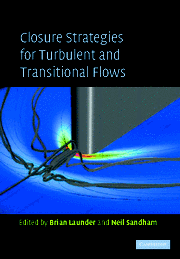17 - By-Pass Transition using Conventional Closures
Published online by Cambridge University Press: 06 July 2010
Summary
Introduction
In attempting to apply turbulence models to transitional flows most practitioners either assume ‘point transition’ at an estimated transition location, and force a switch between laminar and turbulent computations at that point, or make use of experimentally-derived correlations to estimate the start of transition and then ‘ramp-up’ the turbulent eddy viscosity by scaling this with an empirical transition function until fully turbulent conditions are attained. These two approaches are generally used in conjunction with mixing length models or even simpler integral methods which remain the most common methods used today for everyday engineering design purposes.
However Priddin (1975) showed that a low-Re k-ϵ model treatment (due to Jones and Launder (1972)) could be used to predict transitional flow as well. Subsequently a few other successful low-Re k-ϵ model variant applications were reported by Arnal et al. (1980), Dutoya and Michard (1981) and then Liu (1989). Other encouraging results were obtained by Arad et al. (1982), using the alternative two-layer k-kl model scheme of Ng, (1971), by Wilcox (1992) using his alternative two-equation k-ω model, and even with a oneequation k-l model adapted by Manartonakis and Grundmann (1991).
At the same time Rodi and Scheuerer (1984) used the low-Re k-ϵ model of Lam and Bremhorst – see Patel, Rodi and Scheuerer (1985) – to perform the first extensive evaluation of such transition predictions for a range of simple test cases and a turbine blade. For free-stream turbulence intensities > 1% they found this model could quite accurately predict the observed by-pass transition (provided the initial conditions were carefully controlled). But early attempts to employ higher level Reynolds Stress Transport (RST) closures, by Donaldson (1969) and Finson (1975) failed to give quantitatively similar agreement with experiment.
The first direct inter-comparison of different modelling techniques for predicting by-pass transition – ranging from the simplest correlation methods to direct numerical simulations – was reported by Pironneau, Rodi, Ryhming, Savill and Truong (1992). Two test cases were considered, based on data provided taken from a series of experimental studies conducted by researchers at Rolls-Royce. These involved transition on a sharp-leading-edge test plate (carefully controlled to avoid leading-edge separation and to maintain nominally zero pressure gradient) under the influence of precisely isotropic 3% (T3A Test Case) and 6% (T3B) free-stream turbulence (fst).
A very wide range of results was obtained from the different computational approaches adopted.
- Type
- Chapter
- Information
- Closure Strategies for Turbulent and Transitional Flows , pp. 464 - 492Publisher: Cambridge University PressPrint publication year: 2002
- 15
- Cited by



